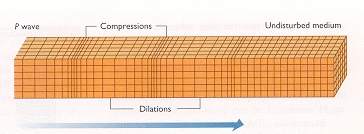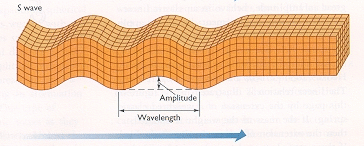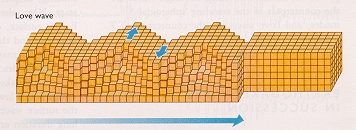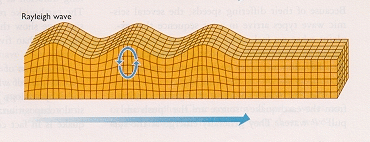

 |
 |
The source of an earthquake is a sudden break on a geological fault. Most of the energy initially stored in the rock complex is used primarily to overcome frictional forces bounding rock segments together. However, a small fraction of this energy is released in the form of seismic waves radiating outwards from the failure surface. Although the length of the 'active' fault is just a few tens of kilometers at most, seismologists often talk about the fault as a point source since the distances to recording sites (or seismograph stations) are many times larger. When forces act on geological faults the rock blocks are subject to both compressional (pressure) and shearing stresses so elastic (seismic) waves radiated outwards during an earthquake are different kinds and travel with different velocities. We differentiate between two main types of seismic waves; body waves which propagate throughout the Earth an surface waves which as their name implies travel along the Earth's surface. These waves travel at different velocities and reach a certain place at different times, finally giving place to a composition of waves called coda. Thanks to it, they can be distinguished in seismograms. Seismologist use the difference in time arrival to locate earthquakes.
We distinguish to types of Body Waves:
These waves are also called Primary waves. They travel like sound waves, alternately compressing and expanding the particles of the earth, pushing them backwards and forwards in the direction of travel. It's like squeezing an eraser, as shown in the next figures:
 |
 |
Aspect of ground in a concrete moment of the p-wave travel during the earthquake: notice how some rocks are compressed and others dilated. |
Movement of single particles in the ground as the p-wave travels through it. The red line could be interpreted as the break of the fault, which push the particles next to it, which in their turn push other particles |
Their speed depend on how easily the material can be compressed, how rigid it is, and its density. They are the fastests waves, and thus the firsts to arrive, travelling at speeds of 4-7 km/sec in the earth crust. They sometimes hit houses with a boom of sound which rattles windows, but they generally don't cause damage on the surface, except in very large quakes.
S-Waves are also called shear waves because they ondulate the ground as a shaken carpet or rope. The motion of individual rock particles in an S wave is transverse to the direcction of wave travel, similarly to the transvers motions in light waves. The wave is transmitted by a shearing motion between particles: it's like bending an eraser rather than squeezing it.
 |
 |
Aspect of the ground in a concrete moment of the S-wave travel during an earthquake: rocks are displaced in a transvers direction related to the direction of propagation (blue arrow). |
>font size=-1>Transverse movement of sigle particles of rock as the S-wave travels through the Earth. |
They travel slower than P-waves, so they will reach any point later. They are the second waves to reach a seismometer. Moreover, their speed depends on the rigidity of the rocks, and because liquids have no rigidity, they cannot travel through them. That's a very interesting property which allow seismologists to locate the focus of earthquakes.
Because of their side to side motion, S-waves are very damaging to
buidings. However, the surface waves which follow in their wake can be
even worse.
As we have already said, surface waves differ from body waves in that they do not travel through the Earth, but instead travel along paths nearly parallel to the surface of the Earth. They result from the transormation of P and S waves when they hit the surface, and they behave like S-waves in that thy cause up and down and side and side movement as they pass, but they travel slower than S-waves.
Again we distinguish two main types of surface waves:
Love waves start arriving just after S waves, or coinciding with them. They have a side to side motion similar to S waves except that they can only exist on the surface. Oddly enough (although it is often the way science progresses), Love and Rayleigh were both mathematicians who proved that such surface waves could theoretically exist, before they were ever actually discovered on the seismograph records.
 |
Side to side motion of the rocks where they are affected by Love waves |
These ones, which come after love waves, churn the ground in a vertical plane like a wave breaking to the shore. Rocks and soil are rotated in the opposite direction to the travelling wave as they are caught up and spun about in it.
 |
Motion of rocks as they are affected by Rayleig waves. |
The dying of an earthquake is composed of a mixture of P, S, Love and Rayleigh waves that have arrived along scattered paths through the complex rock sturcture, due to reflection and refraction. The result is a train of surface waves, composed by several frequencies, which is called coda, by analogy with the final section of a musical composition
In a very large earthquake, seismic waves pass right through the earth and then continue to bounce around inside it. In some cases vibrations can be reflected back and forth through the earth for as long as a month. When sufficent enerfy is released in an earthquake it can set the whole earth ringing like a bell. The 'tone' is a very low one, however. It takes the earth 54 minutes to complete one cycle of its lowest tone (compared to over 200 cycles per second for middle C on a piano), but many higher frequencies also set it 'singing'.